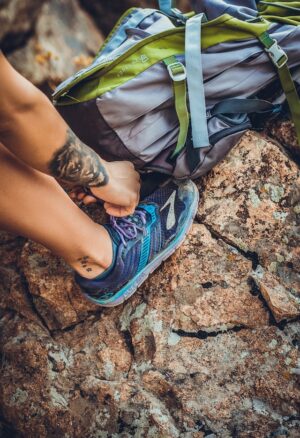The choice of clothing and equipment for climbing varies based on factors such as the climber’s experience level, climbing style, and weather conditions. However, there are certain items that are essential for any climber, regardless of these factors. Let’s take a look at them.
Simple and Essential Clothing
There is no need to search for specific clothing items; to climb comfortably and safely, it is enough to dress in comfortable and lightweight attire. Everyone has their own sense of comfort, and some climbers feel comfortable climbing even in jeans. However, we still recommend opting for a breathable t-shirt and long pants that allow free movement and reaching the most challenging points. Depending on the season, you may prefer short-sleeved t-shirts, tank tops, thermal shirts, or lightweight fleeces. The main idea is always to wear what makes you feel comfortable and free.

Must-Have Climbing Equipment
The tools you cannot do without during your climbing sessions are:
Helmet: An important element to protect your head from potential rock falls or other hazards. When choosing your helmet, make sure it is adjustable so that it is not too tight but remains securely on your head. Most helmets have a rear dial that allows you to tighten or loosen it according to your preference. Another factor to consider is ventilation; generally, foam-based helmets offer better ventilation. You should also check the fit of the chin strap buckle so that once the helmet is fastened, it doesn’t feel loose.
Climbing shoes: Essential for climbing safely and having a good grip on the rock. When choosing climbing shoes, it is important to consider three factors: the morphology of your feet, including width and shape, the intended use of the shoes (the type of wall or duration of use), and your experience level. For example, if you are a beginner, it is advisable to use stiffer models that properly support your feet.
Slings and carabiners: Important for securing the climber to the rock and therefore must be very sturdy and safe. When choosing carabiners, make sure they comply with EU regulations. Then, you can choose to use carabiners with locking gates that offer maximum security or basic carabiners without a locking mechanism, primarily used as quickdraws.
Rope: Used for progression along the wall. It should be chosen based on the type of climbing, and its length should vary according to the route length. There are different types of ropes designed to meet various needs. Single ropes are the most common and are designed to be used alone. Twin ropes, as the name suggests, are meant to be used in pairs, are lighter, have a smaller diameter, and need to be attached together at each anchor. Half ropes are also designed to be used in pairs, but unlike twin ropes, they don’t need to be attached together at each anchor.
Chalk bag: This is the bag used to carry magnesium carbonate (chalk). Chalk is essential for any type of climbing as it helps dry your hands and make them more grippy on the rock. Therefore, it should always be within reach in the designated bag.
Harness: Used to secure the climber to the rope, it should be comfortable and fit well on the body. Finding the right harness for you is crucial to ensure you can be properly secured in case of a fall and to allow you to move freely during climbing.
It is also important to always have a first aid kit with you to respond to any eventualities that may occur during climbing, as well as a water bottle. Finally, before starting any climb, we recommend checking the weather forecast and ensuring you have all the appropriate equipment and clothing.
Once you have purchased all the necessary gear and clothing, you may consider personalizing them to make them recognizable
and unique. For this purpose, you can rely on a graphic agency that will customize your sportswear, making you stand out from the crowd!
Personalizing your clothing and equipment not only adds a touch of individuality but also makes it easier to identify your gear among others. It can be especially helpful when climbing in a group or in busy climbing areas.
Consider adding your name, initials, or a unique design to your helmet, harness, or chalk bag. This way, you’ll not only have gear that reflects your personal style but also makes it easier to distinguish it from others.
There are various methods to personalize your climbing equipment, such as embroidery, heat transfer, or custom stickers. Choose a reputable graphic agency or contact a local printing shop specializing in customizations to discuss your ideas and find the best method for your gear.
Remember, personalizing your climbing equipment is not only about aesthetics but also about safety. When others can easily recognize your gear, it reduces the chance of mix-ups or confusion, ensuring that you use your own trusted equipment every time.
So, go ahead and make your climbing gear unique and recognizable, while staying safe and enjoying the thrill of the sport!